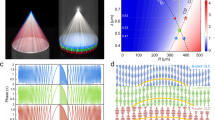Abstract
In this paper, a possibility is shown to realize a simple waveguide polarizer producing nearly the same circular polarization over a broad frequency range up to an octave. It is based upon the combination of two smoothly squeezed oversized waveguides with different diameters. The principle is similar to an achromatic lens in optics, where two counteracting lenses with differently sloped wavelength dependencies of the refractive index are combined to compensate the dispersion in the desired wavelength range. Consequently, two different wavelengths of light are brought into focus at the same plane. A waveguide for the transmission of microwaves has a similar frequency dependence of the refractive index resulting in a frequency-dependent phase shift between two propagating waves polarized along the symmetry axes of a waveguide with an elliptical cross section. For this reason, an incident wave with a linear polarization between the axes of symmetry can be only converted into a circularly polarized wave over a limited frequency range. However, the diameter and the shape along two counteracting squeezed waveguides can be adjusted in such a way that the frequency dependence of the resultant phase shift is finally canceled out.








Similar content being viewed by others
Notes
A general rule will be given at the end of Section 2.2.
I II = 4.4 ⋅ 10−5 m2
a 2(z w)=a 2,max sin2(π z w/L)
The desired shape a 2(z w) was milled into an aluminum block which was supplemented with two slits at two opposite sites to provide the two squeezing plates and two shaping rids. This allows a better control of the final shape because the outer side of the waveguide tube is pressed against the two shaping rids preventing a buckling of the waveguide wall.
The squeezing process was divided in four steps. After each step, the resultant frequency-dependent phase shift was checked by measurement of the relative phase shift of a wave with electric field \(E_{\mathrm {r}}^{\mathrm {a}}\), shown in Fig. 5, and \(E_{\mathrm {r}}^{\mathrm {b}}\), achieved by 90° rotation of the middle waveguide part. The linear polarization at input and output is fixed by the used waveguide converters from standard rectangular (WR-28) to circular cross section (a 0 = 4 mm). The necessary taper from a 0 = 4 mm to a 0 = 5 mm was also optimized with the above-mentioned coupled wave implementation to minimize the spurious mode generation.
The measurement was accomplished with the aid of a swept frequency interferometer whose dwell time was considerably increased so that only the stable phase relation was evaluated.
In contrast, the measured and expected phase shift within the frequency range 60–90 GHz are in very good agreement as apparent from Fig. 3.
The ECE diagnostic of W7-X uses a smooth-walled waveguide with a radius of a 0 = 13.895 mm as transmission line between the in-vessel antenna and the diagnostic front-end [8]. This waveguide dimension standard will be maintained at W7-X, even though an upgrade to the corrugated counterpart is imaginable in the next years. An EBE diagnostic will have a similar setup as the ECE diagnostic and would use the same waveguide standard.
The maximum change of the waveguide radius is a 2,max = 4.3 mm using a shape function a 2(z w)=a 2,max sin2(π z w/L).
Under these conditions the maximum change of the waveguide radius is a 2,max = 0.1 mm including a loss of 0.1 dB at 55 GHz.
References
H.-J. Hartfuß, T. Geist, Fusion Plasma Diagnostics with mm-Waves - An Introduction (John Wiley And Sons, Inc., 2013), pp. 117–150, 357–377
H. P. Laqua, H. J. Hartfuß, and W7-AS Team, Phys. Rev. Lett. 81, 2060 (1998)
M. A. Heald, C. B. Wharton, Plasma Diagnostics with Microwaves (Wiley, New York, 1965), pp. 316–324
J. G. Kretzschmar, IEEE Trans. Microw. Theory Tech. MTT18, 547 (1970)
F. Volpe, H. P. Laqua, W7-AS Team, Rev. Sci. Instrum. 74, 1409 (2003)
J. L. Doane, Int. J. Electronics 61, 1109 (1986)
M. Thumm, H. Kumric, Int. J. Infrared and Millim. Waves 10, 1059 (1989)
S. Schmuck, H.-J. Hartfuss, M. Hirsch, T. Stange, Fus. Eng. Des. 84, 1739 (2009)
Acknowledgments
The author wants to thank Norbert Lamprecht of the technical staff of the IPP Greifswald for the precise machining of the various parts of the polarizer. Further thanks go to Dr. Heinrich Laqua and Dr. Matthias Hirsch for the fruitful discussions.
Author information
Authors and Affiliations
Corresponding author
Rights and permissions
About this article
Cite this article
Stange, T. Simple Broadband Circular Polarizer in Oversized Waveguide. J Infrared Milli Terahz Waves 37, 137–146 (2016). https://doi.org/10.1007/s10762-015-0213-1
Received:
Accepted:
Published:
Issue Date:
DOI: https://doi.org/10.1007/s10762-015-0213-1




